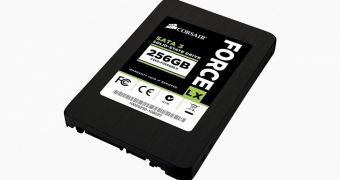Corsair has released a pair of solid-state drives which, it claims, are cheap compared to the competition, but that's pretty debatable considering the tags we've found on the websites of online retailers.
The new SSDs go by the name of Force Series LX and have capacities of 128 GB and 256 GB. Their prices are of $75 / €75 and $130 / €130, respectively.
And this is where the debate may begin. Corsair says that these are low prices for such SSDs, but we've found plenty of drives of similar capacities that sell for less, like the ADATA Premier Pro ($70 / €70) and a 128 GB Transcend drive.
It's not made better by how the official Corsair Force Series LX SSD web page seems to have added $25-30 / €25-30 to the two price points for some reason.
On the flip side, those older SSDs are significantly slower than the new Corsair units. ADATA's, for example, has read and write speeds of 360 MB/s and 130 MB/s, respectively.
Corsair's Force Series LX can read data at 560 MB/s (there aren't any SATA SSDs faster than that, as far as we know), while files can be written at 300 MB/s.
A fairly big difference for Corsair SSDs, which usually work at over 500 MB/s even when writing data, but that's expected.
Corsair did, after all, intend for the Force Series LX units to be the affordable ones of the bunch, if only by comparison.
Anyway, the newcomers are 7 mm thick and use Silicon Motion SSD controllers to achieve the data rates mentioned above.
They are clad in aluminum and, thus, can not only be installed in desktops, but can also upgrade notebooks.
And if you do what you're supposed to and reinstall the operating system on the solid-state drive, you'll experience blindingly fast boot times and application launching.
TRIM, NCQ and S.M.A.R.T. technologies are installed on the newcomers by the way, meaning that drive performance is maintained over time.
This is one of the big problems of SSDs, or was: due to the finite number of write cycles, performance drops over time. The three techniques mentioned above (not so much S.M.A.R.T., but the other two) will continuously clear up the sectors where deleted files used to be, among other things.
If you go ahead and buy one of the Force Series LX SSDs, and only had an HDD before, you should enjoy a tenfold increase in OS performance. And just so we're clear, 300 MB/s isn't a low writing speed, it's just low by comparison to the SSD read performance. Compared to HDDs, it's still a lot better.

 14 DAY TRIAL //
14 DAY TRIAL //